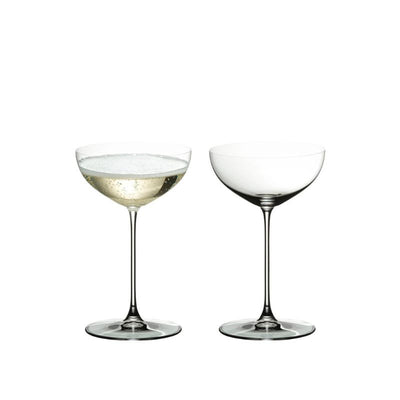The Martini: A Cocktail of Elegance and History

I've had a busy couple of weeks here at Riedel Towers. Staff holidays meant I was drafted in to help picking and packing in the warehouse, and then we had our biggest ever delivery arrive (all 3.5 tonnes of it!) which took the best part of 5 days to check in and put away.
Hence, no email from me last Saturday. I was planning on sharing a piece about the Martini (as we had just had this years World Martini Day), but, as time got the better of me, I thought I'd file it away and use it next year.
However, on looking at The Riedel Shop's June performance, and then expanding that to the last 12 months, I noticed that one of our best selling glasses was, surprisingly, the Riedel Nick and Nora Glass.
Named after wisecracking, husband and wife detectives, Nick and Nora Charles, from Dashiell Hammett’s The Thin Man, who drink enough Martini's to sink the Titanic, these beautiful little glasses were our best sellers last month, and second best sellers over the last year.
When you consider that the Vinum Cabernet Sauvignon / Bordeaux Glass and the Vinum Pinot Noir / Burgundy Glass have occupied the top spots for as long as I can remember, it means that more than a few of us have been enjoying a Martini.... Anytime, Anyplace, Anywhere...
Why?
Few cocktails capture the essence of sophistication and elegance quite like the Martini. This simple mixture of gin (or vodka) and vermouth, often garnished with an olive or a lemon twist, has become a symbol of refinement and a staple of cocktail culture.
From its disputed origins to its current status as a pop culture icon, the Martini has a rich and fascinating history.
History and Origins:
The exact origins of the Martini are shrouded in mystery and debate. Several theories exist about its creation:
One popular account suggests that the Martini was first mixed in the 1860s at the Occidental Hotel in San Francisco. According to this story, a gold miner, after striking it rich, wanted to celebrate and the bartender concocted a special drink using gin and vermouth, which he named after the nearby town of Martinez. This story is supported by a similar cocktail recipe, the Martinez, which includes Old Tom gin, sweet vermouth, maraschino liqueur, and orange bitters. Indeed, a "Martinez Cocktail" was first described in Jerry Thomas' 1887 edition of his Bartender's Guide, How to Mix All Kinds of Plain and Fancy Drinks.
 |
Another theory attributes the Martini to a New York bartender named Martini di Arma di Taggia, who supposedly created the drink in 1912 at the Knickerbocker Hotel. His version used London dry gin and dry vermouth, very similar to the dry Martini we know today. A third possibility involves the Italian vermouth brand Martini & Rossi, which was established in 1863. The argument here is that the cocktail was named after the vermouth, a key ingredient. |
Regardless of its true origins, the Martini became firmly established in the American cocktail culture by the early 20th century.
Its popularity surged during Prohibition (1920-1933), as gin was relatively easy to produce illicitly.
The end of Prohibition saw the Martini's rise to global fame, cementing its place as a symbol of glamour and sophistication.
Evolution of the Recipe:
Over the decades, the Martini's recipe has undergone several transformations:
Early Martinis: The original recipes often called for equal parts gin and vermouth, creating a much sweeter drink than modern versions.
The "Dry" Trend: Starting in the 1920s, the trend toward "dry" Martinis began, with less vermouth being used over time. By the mid-20th century, some aficionados were merely rinsing the glass with vermouth.
Vodka Revolution: In the 1960s, vodka began replacing gin in many Martinis, partly due to clever marketing by vodka brands and changing consumer tastes.
Modern Variations: Today, countless variations exist, including the Dirty Martini (with olive brine), the Gibson (garnished with a cocktail onion), and fruit-flavoured "martinis" that often bear little resemblance to the original.
Famous Fans and Cultural Impact:
The Martini has been the favoured drink of numerous celebrities, historical figures, and fictional characters:
Ernest Hemingway: The acclaimed author was known for his love of cocktails, and the Martini was no exception. Hemingway preferred his Martinis extra dry, with just a hint of vermouth. He once described his ideal Martini as “ice cold, very strong, very well-made with a large slice of lemon peel.” He was also known for his "Montgomery Martini," which used a 15:1 gin to vermouth ratio.
Franklin D. Roosevelt: The 32nd US President was fond of Martinis and often mixed them himself during his term in the Oval office.
James Bond: Perhaps the most famous Martini aficionado is Ian Fleming’s iconic spy, James Bond. Bond’s preference for a "Vodka Martini, shaken, not stirred" has become legendary, immortalising the drink in popular culture. This phrase first appeared in the 1953 novel "Casino Royale" and has since become a signature line in James Bond films.
Frank Sinatra: The legendary singer and actor often enjoyed Martinis and made them a staple at his Rat Pack gatherings. Sinatra's style and charisma were perfectly complemented by the perceived sophistication of the Martini.
Dorothy Parker: The wit and writer famously quipped, "I like to have a Martini, two at the very most. After three I'm under the table, after four I'm under my host."
Winston Churchill: Winnie was famously quoted as saying that the perfect Martini should involve just waving the glass in the general direction of Italy, where vermouth is made, or merely glancing at the vermouth bottle while pouring gin. Churchill’s extremely dry preference contributed to the Martini's evolution, emphasising the gin over the vermouth.
Humphrey Bogart: The Hollywood star once said, "The problem with the world is that everyone is a few drinks behind," reflecting his fondness for, more than, a few well-made Martinis. Bogart's on-screen presence and off-screen habits helped cement the Martini's status as a classic cocktail.

Interesting Facts and Figures:
Martini Variations: The classic Martini consists of gin and dry vermouth, garnished with an olive or a lemon twist. However, numerous variations exist, including the Vodka Martini, the Dirty Martini (with a splash of olive brine), and the Gibson (garnished with a cocktail onion).
Proportions Matter: The ratio of gin to vermouth can vary greatly. A traditional Martini might have a 2:1 ratio, while an "Extra Dry" Martini might have just a few drops of vermouth. Some modern interpretations go as far as to use a mere rinse of vermouth or none at all, emphasizing the spirit’s purity.
Shaken vs. Stirred: While James Bond prefers his Martini shaken, traditionalists argue that stirring preserves the drink's clarity and texture. Shaking can introduce air bubbles and dilute the drink more quickly. Stirring is said to result in a smoother, more aesthetically pleasing cocktail, while shaking is believed to chill the drink more effectively.
The Martini Glass: The iconic V-shaped Martini glass is designed to enhance the drinking experience. The wide bowl allows for the aromas to be fully appreciated, while the long stem keeps the drink cool by preventing the warmth of the hand from affecting the cocktail. The glass itself, very quickly, became a symbol of the Martini’s elegance and style.
World’s Most Expensive Martini: The record for the most expensive Martini was set in 2003 at the Ritz-Carlton in Tokyo, priced at $17,000. It included a one-carat diamond as a garnish. This extravagant version underscores the Martini's association with luxury and opulence.
Martini in Literature and Film: The Martini has appeared in countless books and movies, further embedding it in our cultural consciousness. From Nick and Nora Charles’ endless stream of Martinis in "The Thin Man" series to the suave charm of James Bond, the Martini continues to signify elegance and sophistication. In Ernest Hemingway's "A Farewell to Arms," the protagonist drinks Martinis while contemplating life's complexities.
Martini’s Role in the Prohibition Era: During Prohibition, gin was relatively easy to produce illegally, making the Martini a popular choice among clandestine drinkers. The quality of the gin varied hugely, leading to the creation of various Martini recipes designed to mask the harshness of homemade spirits. This period also saw the rise of speakeasies, where the Martini became a symbol of rebellion.
Evolution of Ingredients: The Martini has evolved over time, with changes in ingredients and preparation methods. Early versions used sweet vermouth, while the modern dry Martini typically uses dry vermouth. The choice of garnish—olive, lemon twist, or cocktail onion—also adds a personal touch.
Cultural Symbolism: The Martini has become more than just a cocktail; it is a cultural symbol of elegance, grace, and refinement. Its presence in art, literature, film, and advertising has cemented its status as an icon of sophistication.
Bond was on to something: A study published in the British Medical Journal, in 1999, investigated whether shaking or stirring a Martini had any effect on its antioxidant properties. They found that shaken Martinis had more antioxidants.
Conclusion:
The Martini's journey from its disputed origins to its current status as probably the most recognisable cocktail in the world, is a testament to its enduring appeal.
Whether enjoyed as a classic gin and vermouth mixture or in one of its many modern variations, the Martini continues to captivate drinkers with its simplicity, elegance, and rich cultural associations.
As tastes and trends in the cocktail world continue to evolve, the Martini remains a constant, a timeless symbol of sophistication in a glass.
Cheers!





















Leave a comment